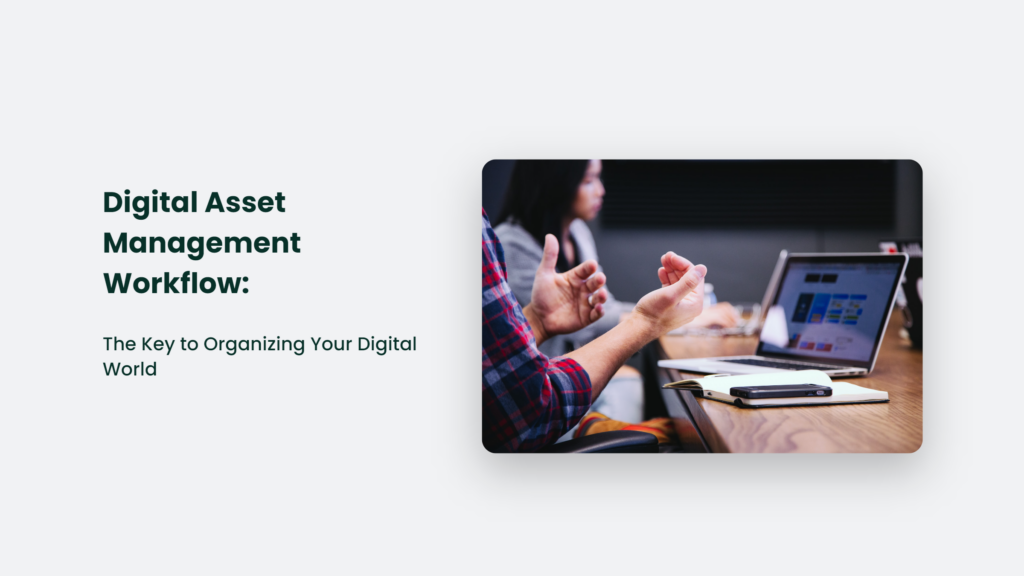

Digital Asset Management Workflow: The Key to Organizing Your Digital World

As Seen On
As someone who’s worked in the digital world for a while now, I can tell you that it’s a wild, wild west out there. With so many different files, folders, and assets floating around, it can be easy to feel like you’re drowning in a sea of digital clutter.
But fear not, my friends! I’m here to tell you about the key to taming the digital beast: a digital asset management workflow.

What is a Digital Asset Management Workflow?
In simple terms, a digital asset management workflow is a system that helps you organize and manage your digital assets. It can include anything from images and videos to documents and audio files. By using a digital asset management workflow, you can ensure that your assets are properly stored, organized, and easily accessible when you need them.
Think of it like a digital filing cabinet, where everything has its place and is easily retrievable. No more digging through folders and folders of files, trying to find that one image you need for your latest project. With a digital asset management workflow, everything is at your fingertips.
Why Do You Need a Digital Asset Management Workflow?
You need a digital asset management workflow for several reasons, but let me highlight the most important ones.
Increased Productivity
When you have a system for managing your digital assets, you can work more efficiently and effectively. You won’t waste time searching for the files you need, and you’ll be able to access them quickly and easily. It will allow you to focus on the creative side of your work rather than getting bogged down in the administrative side of things.
Improved Collaboration
A digital asset management workflow is essential if you’re working with a team. It allows everyone to access the same files and assets, ensuring everyone is on the same page. It can be beneficial when working on large projects, as it ensures that everyone has the latest versions of files and assets.
Better Asset Management
With a digital asset management workflow, you can manage your assets better. You’ll know exactly where everything is, and you’ll be able to track who’s using what files and when. It can be beneficial if you’re working on a project with a tight deadline, as it ensures you have all the assets you need when needed.
Increased Security
Finally, a digital asset management workflow can also increase the security of your digital assets. With everything properly organized and stored, you can keep your assets safe from prying eyes and accidental deletion.
How to Set Up a Digital Asset Management Workflow

Now that you understand why you need a digital asset management workflow let’s talk about how to set one up.
Identify Your Assets
The first step in setting up a digital asset management workflow is identifying the assets you need to manage. List all the assets you need to manage and categorize them into different types. It can include anything from images and videos to documents and audio files.
Choose a Digital Asset Management Tool
Once you’ve identified your assets, it’s time to choose a digital asset management tool. Many different tools are available, so you’ll want to choose one that meets your specific needs. Some popular options include Adobe Experience Manager, Widen Collective, and Bynder.
Create a Folder Structure
Once you’ve chosen your digital asset management tool, you’ll want to create a folder structure. It will allow you to organize your assets in a way that makes sense to you and your team. Start by creating a main folder for each type of asset, and then create sub-folders as needed. For example, you might have a main folder for images, with sub-folders for different categories of images, such as product images, marketing images, and employee headshots.
Establish a Naming Convention
To make it easier to find your assets in the future, you’ll want to establish a naming convention. It can include things like using consistent file names and file formats and including keywords in the file names to help with searchability.
Set Up Access Controls
Once you’ve set up your folder structure and naming convention, it’s time to set up access controls. It will determine who has access to which assets and what they can do with them. For example, you might give certain team members access to certain folders but restrict their ability to delete files.
Regularly Back Up Your Assets
Finally, it’s essential to back up your assets regularly. It will ensure you don’t lose important files if your digital asset management tool fails or your computer crashes. Many options for backing up your assets include cloud storage solutions like Dropbox or Google Drive and external hard drives.
Frequently Asked Questions:
Why do I need a digital asset management workflow?
A digital asset management workflow can increase your productivity, improve collaboration with your team, better manage your assets, and increase the security of your digital assets.
How do I set up a digital asset management workflow?
To set up a digital asset management workflow, you’ll need to identify your assets, choose a digital asset management tool, create a folder structure, establish a naming convention, set up access controls, and regularly back up your assets.
Conclusion:
A digital asset management workflow is essential in today’s digital world. It can help you organize your assets, increase your productivity, and ensure that you always have access to the files and assets you need when you need them. So, what are you waiting for? Get started on your digital asset management workflow today!
As the great digital guru, Steve Jobs once said, “Design is not just what it looks and feels like. Design is how it works.” And with a solid digital asset management workflow in place, your digital world will look and feel organized and work efficiently and effectively, allowing you to focus on the things that truly matter.
Konger
Up until working with Casey, we had only had poor to mediocre experiences outsourcing work to agencies. Casey & the team at CJ&CO are the exception to the rule.
Communication was beyond great, his understanding of our vision was phenomenal, and instead of needing babysitting like the other agencies we worked with, he was not only completely dependable but also gave us sound suggestions on how to get better results, at the risk of us not needing him for the initial job we requested (absolute gem).
This has truly been the first time we worked with someone outside of our business that quickly grasped our vision, and that I could completely forget about and would still deliver above expectations.
I honestly can't wait to work in many more projects together!
Disclaimer
*The information this blog provides is for general informational purposes only and is not intended as financial or professional advice. The information may not reflect current developments and may be changed or updated without notice. Any opinions expressed on this blog are the author’s own and do not necessarily reflect the views of the author’s employer or any other organization. You should not act or rely on any information contained in this blog without first seeking the advice of a professional. No representation or warranty, express or implied, is made as to the accuracy or completeness of the information contained in this blog. The author and affiliated parties assume no liability for any errors or omissions.

